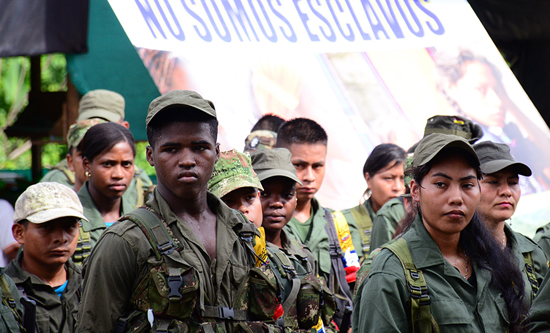
The Santos government and the Revolutionary Armed Forces of Colombia (FARC) set 23 March 2016 as the deadline to sign a final peace agreement, but negotiations in Cuba have stalled in past months over the last question on their agenda – decommissioning FARC’s armoury and demobilisation. On 10 March both sides announced that they aim to reach a deal by the end of the year. Since November 2012 – in long negotiations punctuated by government killings of FARC leaders – agreement has been reached on approaches to land reform, political participation, the illegal drugs trade and transitional justice. Alvaro Michaels reports.
On 21 March in Havana, US Secretary of State John Kerry again urged the Colombian government and FARC to reach a peace accord. Obama will ask the US Congress for $450m (£312m) as a sweetener after completion. To back Santos’s final shift against opponents from the large landowning class and sections of the military, Kerry defended the Santos-FARC talks by pointing out that it is not the FARC, but ‘right-wing militias’ that are currently ‘increasing the violence’. FARC quickly pushed for the State Department to remove the guerrilla army from its list of ‘foreign terrorist organisations’. When a peace agreement is reached, a referendum will be held for its approval.
President Santos has now discarded ex-President Alvaro Uribe as a useful bargaining tool in his negotiations with FARC, finally approving the arrest of Uribe’s brother Santiago on 29 February. He is accused of involvement in murders and forced disappearances in the 1990s. The family’s dealings with the drug trade (father, cousins, in-laws), known to US intelligence, made President Uribe pliable to US pressure when in office.
Demonstrations continue across the country supporting the peace process and demanding action against the killing of activists, more than 30 in the past month. These murders jumped 35% from 78 in 2014 to 105 in 2015. More than 100 women from the Marcha Patriotica movement occupied San Francisco cathedral in the capital Bogota on 19 March, demanding that the Catholic Church condemn the wave of killings, forcing Interior Minister Cristo to announce a special investigation. In Medellin, violence against pro-peace community organisers by demobilised paramilitary forces saw five activists murdered in March, with countless more grassroots organisers forcibly displaced by the threat of violence. The ceasefire, which FARC has held to, has not contributed to a decline in such killings of civilians because they are conducted by right-wing paramilitary groups aligned with Colombian businesses and the state.
The economic crisis
The GDP growth rate fell from 6.6% in 2011, to 3.1% in 2015, with 2.5% expected in 2016, giving less room for the state to manage the demobilisation of FARC or make small concessions to the masses, as well as working for the wealthy. The oil price slump has hit Colombia. Coal and coke exports fell heavily last year. This January, total exports fell sharply again. The trade deficit worsened in 2015 to $15.9bn, even though imports dropped $9.5bn. In February, a 3.0% cut in the country’s 2016 budget followed falling tax revenues. The central bank raised the base rate to 6.5% on 18 March, the seventh time running.
The shift in Colombian state politics stems from its inability to defeat the revolutionary opposition. Land enclosure and the violent expulsion of the rural population to the towns over the past 50 years has still not created the conditions for the effective exploitation of the country on the scale necessary for the accumulation needs of capital at a global level. That illegal groups are now gaining huge profits from providing machinery and protection for illegal mining, eg gold, illustrates this. Should a peace deal be struck, struggles by local populations such as that in Putumayo over the AmeriSur Binational Oilduct (OBA), allowing oil interests in Putumayo to export crude via Ecuador, will become much more vigorous. They have no choice – 34 of the 102 indigenous tribes, over 62% of all Colombia’s indigenous peoples, are on the verge of extinction. The main cause is mining by large corporations.
Poverty
In Colombia, a middle income country, income distribution is the third most unequal in Latin America and tenth in the world. Just over 1% of landowners own more than half of rural land. Some 40% of Colombian territory is under some type of contract with multinational corporations, either for the production of biofuels or for agriculture, forestry, or mining.
Poverty is most obvious in rural areas: in 2014, 42.8% of the rural population were poor compared to 26.9% in towns. In rural areas, where about a quarter of Colombia’s 47.2 million people live, 19.1% live in extreme poverty compared to 6% in towns. An estimated 1.3 million rural families are landless. Over 13% of Colombia’s under-five-year-olds suffer from malnutrition and 3% suffer from chronic malnutrition. The indigenous peoples suffer worse rates, of 29.5% and 7.5% respectively.
Transition or exclusion
The National Liberation Army (ELN), founded in 1964 as a Marxist guerrilla group to fight Colombia’s unequal distribution of wealth, remains excluded from the Havana talks by the government, despite exploratory discussions. Ivan Marquez, FARC’s chief negotiator, has insisted that ‘The ELN cannot stay outside the peace process.’ If the FARC is simply demobilised – the crux of negotiations now – the danger for rural workers is that criminal gangs and paramilitary groups will fill the gap, terrorising previously stable and peaceful zones. The ELN has already reconnoitred areas where FARC has withdrawn, to assess the situation. If the current discussions do not satisfy all FARC members, and the ELN continues to be excluded, FARC rebels who disagree with any deal will work with the ELN. Whatever the outcome of the current discussions, 55 years of FARC’s political experience in the class struggle won’t be abandoned.
Fight Racism! Fight Imperialism! 250 April/May 2016




